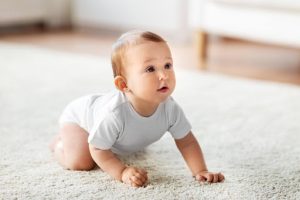Milestones in the first few years of a child’s life can be a really exciting time for you and your little one. As kids develop new skills, like rolling, sitting, first words, walking and different ways of playing, they also experience lots of other benefits that help to set them up for skills later in life. Essential milestones are important for helping kids develop the building blocks that help them to participate in activities as they grow and develop their own interests.
In 2021, the Centers for Disease Control and Prevention (CDC) and the American Academy of Pediatrics (AAP) removed crawling from the list of official milestones that we expect a child to achieve. Does this mean that crawling isn’t important for babies to do before walking? At CKH we think crawling is REALLY important and here are some reasons why.

Helps develop strength in muscles and joints
Crawling engages your entire body! This means this crawling will help with your child’s strength in many different areas including head and neck strength, upper limb strength and core strength. Some key areas that crawling allows for, more so than other positions and movements are:
Upper limb strength
Crawling is likely the longest period of time that your child will spend putting weight through their hands, arms and shoulders, leading to an increase in strength and stability. This helps with activities such as drawing and colouring, playing with different toys, and self-care tasks such as dressing and feeding themselves.
Core strength
In order for your child to be able to move their arms and legs at the same time, they need to be able to use their core muscles for stability so that they don’t lose balance. Having good core strength will make it much easier for your child to progress onto other motor skills, such as walking, running and balancing tasks. It will also be really important for your child’s ability to sit with ease to perform a task, such as playing on the floor or being able to sit on a chair and concentrate in school when they’re older.
Crawling in the first form of independent movement
Crawling is likely the first time your child has been able to efficiently get themselves around, allowing them to explore and interact with new things. This allows your child to develop an understanding of where things are in their environment (developing navigation skills), allows for additional opportunities for problem solving and interacting with new objects, helps enhance depth perception and other visual perception skills and promotes some early independence.
Helps brain development
An important part of brain development is learning to use both hemispheres of the brain at the same time, enabling effective communication between both sides of the brain. As crawling utilises both sides of the body, it engages both sides of the brain, helping develop more effective pathways for communication. This will impact your child’s ability to learn new information, regulate their emotions and cross their midline.
Improves coordination, motor planning and spatial awareness
Crawling on hands and knees gives your child lots of input and feedback through their body. This helps them to develop a better understanding of where their body is in space, which in turn gives them a better understanding of how to control and move their body. In using both arms and legs for different skills throughout crawling, it provides early opportunities to develop both upper and lower limb coordination skills. All of this will increase the ease of skills such as throwing and catching, kicking a ball, skipping and participating in sports and games as your child continues to develop.
Fine motor benefits
To be able to develop fine motor skills, it’s essential to have good upper limb and core strength, which as we’ve already touched on, crawling is great for!
Crawling also helps children develop more precise movements by giving them access to new and different inputs, meaning they have many more opportunities to play and interact with new objects. The process of crawling also helps children learn how to separate parts of their hand (e.g. being able to point or isolate different fingers), making hand movements more precise and meaningful.
Sensory benefits
Crawling is a great way for your child to be able to explore and experience new textures and feelings though their hands (think carpet, tiles, grass, dirt, etc.). This gives little ones an opportunity to understand and process different inputs, as well as helping them to better understand the role of different senses (e.g. that different things feel different on their hands, different objects might taste and smell differently, etc.). This is an essential part in children learning to understand and make sense of things in their environment.
There are many more skills and benefits that your child will gain from crawling, so we think it’s pretty great! If your child is struggling with crawling on their hands and knees and you’d like some suggestions to help, get in touch with our Physio team via 6360 2018.



